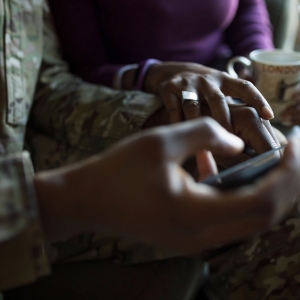What Can Be Done to Stem the Rise of Military Suicides?
July 02, 2018 / by Marc Ballon- Research
Two USC schools try to identify at-risk active military personnel and veterans
As suicide rates among active-duty service members and veterans continue to outpace rates among the general population, researchers from the USC Viterbi School of Engineering and the USC Suzanne Dworak-Peck School of Social Work have joined forces to use technology to identify, as early as possible, those at risk.
The collaboration, as part of the USC Center for Artificial Intelligence in Society, or USC CAIS, is believed to be one of the first of its kind to use artificial intelligence to model the strength or weakness of military personnel’s social networks to ascertain suicidal thinking, depression and anxiety. The work by the USC interdisciplinary research team will be supported by a $600,000 grant from the Army Research Office.
“The hypothesis is that we are going to be able to capture, via machine learning, some patterns that show when a certain set of changes in the social network happens over a certain period of time that might be an indicator of suicidal thoughts,” said Milind Tambe, a professor of computer science, co-founder of CAIS and holder of the Helen N. and Emmett H. Jones Professorship in Engineering.
Military Suicides: Rates
An estimated 8,000 military veterans commit suicide every year, according to a 2012 report issued by the U.S. Department of Veterans Affairs. Additionally, one active-duty member kills himself or herself every 36 hours, according to 2010 statistics from the Centers for Disease Control and Prevention.
Team members hope to use the lessons learned from their study to increase early interventions for at-risk military personnel and veterans facing acute stress during transitional moments. The members include Tambe; Eric Rice, USC CAIS co-founder and associate professor in social work; Carl Castro, associate professor, retired U.S. Army colonel and director for the USC Center for Innovation and Research on Veterans & Military Families; and Phebe Vayanos, an assistant professor of industrial and systems engineering and computer science and associate director of USC CAIS.
The transitional moments include deployment, returning home from service, joining and leaving the military, and transferring to a different duty assignment in the U.S. and abroad.
“If we could collect data on people over a period of time, we could look at changes in their social networks to understand when and where and at what moments people become more at risk of suicide,” Rice said.
Researchers are working with the Army to identify 200 to 300 soldiers they could follow for one year, hopefully beginning this summer. Researchers would survey and interview the cohort during soldiers’ six-month deployments and then follow up every month for another six months back home, Rice said.
The team would evaluate how much they continue to engage with battalion members back in the U.S., how well they reintegrate with their families, the challenges soldiers face when transitioning to civilian life and what happens if one’s social network of friends and loved one atrophies, among other areas of inquiry.
Disposed to Depression and Substance Abuse
Military personnel seem more disposed to depression, substance abuse and suicidal thoughts than the general population, Castro said.
“Military life is hard for a variety of reasons, including an increased exposure to trauma, frequent moves that disrupt one’s social support networks and prolonged separations due to deployments,” he said. “Further, the physical nature of the military leads to chronic musculoskeletal injuries, resulting in chronic pain that service members treat through self-medication, which can lead to addictions.”
As a “proof of concept,” Rice said, the USC CAIS team will begin using information, collected between 2011 and 2014 for another project, to look at suicidal thinking among homeless youth. Rice said he has rich data on 1,046 Los Angeles homeless youth. Like veterans and active-duty personnel, homeless young people have higher suicide rates, self-contained social networks and are considered “special populations,” he added.
With both projects, machine learning could make the algorithms smarter over time and save lives in the process, Tambe said.
“In the future, the machine might be able to make some predictions about what a danger sign might be,” he said. “We don’t expect this to be perfect, but, hopefully, it will give us some hints about where we might be able to offer some assistance or strategically focused interventions.”
To reference the work of our faculty online, we ask that you directly quote their work where possible and attribute it to "FACULTY NAME, a professor in the USC Suzanne Dworak-Peck School of Social Work” (LINK: https://dworakpeck.usc.edu)
